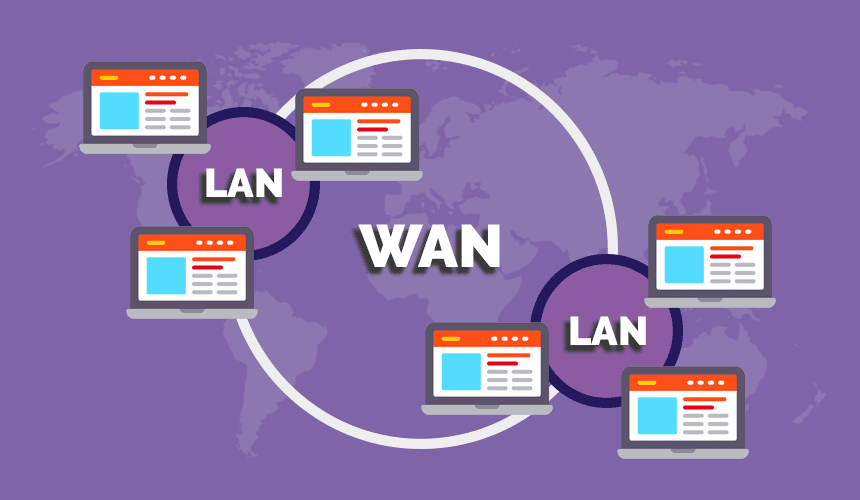In the realm of networking, two acronyms frequently surface: WAN (Wide Area Network) and LAN (Local Area Network). These terms represent two different types of networks, each with distinct characteristics, uses, and technological underpinnings. Understanding “wan vs lan” is crucial for anyone involved in IT, from network administrators to business owners seeking efficient connectivity solutions. This blog aims to demystify these concepts, exploring their differences, applications, and the technologies that drive them.
What is a LAN?
A Local Area Network (LAN) is a network that connects computers and devices within a limited area, such as a residence, school, laboratory, or office building. A LAN is characterized by high data transfer speeds, low latency, and limited geographic range.
Characteristics of LAN:
- Geographic Scope: Typically spans a small area such as a single building or a campus.
- Speed: High-speed connections, often ranging from 100 Mbps to 10 Gbps.
- Latency: Low latency due to the proximity of devices.
- Connectivity: Usually utilizes Ethernet cables, Wi-Fi, or fiber optics.
- Cost: Relatively low installation and maintenance costs.
Applications of LAN:
- Office Networks: Connecting workstations, servers, printers, and other devices in an office environment.
- Home Networks: Linking personal computers, smart TVs, gaming consoles, and home automation devices.
- Educational Institutions: Facilitating communication and resource sharing among computers in schools and universities.
What is a WAN?
A Wide Area Network (WAN) covers a broad geographic area and connects multiple LANs. WANs are essential for businesses and organizations that operate in multiple locations, providing a means for long-distance communication and data sharing.
Characteristics of WAN:
- Geographic Scope: Spans large areas, often nationwide or international.
- Speed: Generally slower than LANs, with speeds varying widely depending on the technology used.
- Latency: Higher latency due to the greater distances involved.
- Connectivity: Utilizes a mix of communication technologies including leased lines, satellite links, and public networks like the internet.
- Cost: Higher installation and operational costs due to the complexity and scale of the infrastructure.
Applications of WAN:
- Global Business Operations: Enabling communication and data exchange between international branches of a company.
- Telecommunications: Forming the backbone of internet connectivity and telephone networks.
- Cloud Services: Connecting users to cloud-based applications and services, which may be hosted in data centers around the world.
Key Differences Between WAN and LAN
Understanding the differences between WAN and LAN is crucial for designing and managing efficient networks. Here are some of the most significant distinctions:
1. Geographic Area
- LAN: Limited to a small area like a single building or a campus.
- WAN: Can cover vast distances, connecting multiple LANs over cities, countries, or even continents.
2. Data Transfer Rates
- LAN: Typically supports very high data transfer rates (up to 10 Gbps and beyond with modern Ethernet technology).
- WAN: Usually offers lower data transfer rates, which can vary from 56 Kbps (in older technologies) to 100 Gbps (in modern fiber optic networks).
3. Latency
- LAN: Exhibits low latency due to the short distances data has to travel.
- WAN: Often has higher latency because data must travel long distances and may pass through multiple intermediate points.
4. Connectivity and Infrastructure
- LAN: Commonly uses Ethernet cables, Wi-Fi, or fiber optics within a localized area.
- WAN: Employs a variety of technologies such as leased lines, MPLS, VPNs, and satellites, often requiring complex infrastructure and cooperation between multiple service providers.
5. Cost
- LAN: Generally inexpensive to set up and maintain due to the localized nature and straightforward infrastructure.
- WAN: More costly due to the extensive infrastructure, long-distance data transmission, and often the need for specialized equipment and service agreements.
6. Reliability and Security
- LAN: Typically more secure and reliable as the network is confined to a controlled environment.
- WAN: May be more vulnerable to security threats and reliability issues due to the larger number of connection points and the vast distances involved.
Technological Components of LAN and WAN
LAN Technologies
- Ethernet: The most common LAN technology, offering high-speed data transfer over twisted-pair cables, fiber optics, or wireless.
- Wi-Fi: Wireless technology for LANs, providing mobility and ease of connectivity for devices within the network’s range.
- Switches and Routers: Hardware devices that manage data traffic within the LAN and connect it to external networks like the internet.
WAN Technologies
- Leased Lines: Dedicated lines rented from a service provider, offering reliable and secure point-to-point communication.
- MPLS (Multiprotocol Label Switching): A technique for directing data from one network node to the next, improving speed and managing traffic efficiently.
- VPN (Virtual Private Network): Provides secure remote access to a LAN over a public WAN such as the internet.
- Satellite Communication: Used for remote areas where traditional wired connections are not feasible, though it comes with higher latency.
Practical Considerations: Choosing Between WAN and LAN
When deciding between WAN and LAN, several practical considerations come into play:
1. Purpose and Scope of the Network
- For internal office communication or home networking, a LAN is usually sufficient.
- For businesses with multiple branches, remote workers, or the need for global connectivity, a WAN is essential.
2. Performance Requirements
- High-speed, low-latency requirements typically necessitate a LAN.
- WAN solutions must be carefully chosen to balance performance with the distances involved.
3. Cost and Budget
- LANs are cost-effective for smaller, localized setups.
- WANs require a larger investment, not just in terms of infrastructure but also in ongoing service costs.
4. Security Needs
- LANs offer more controlled security environments.
- WANs need robust security measures due to their exposure to public networks and wider attack surfaces.
Emerging Trends and the Future of WAN and LAN
The landscape of networking is continually evolving, influenced by technological advancements and changing user needs. Here are some emerging trends:
1. Software-Defined Networking (SDN)
- SDN is revolutionizing both WAN and LAN by decoupling the control plane from the data plane, allowing for more flexible and efficient network management.
2. 5G and Beyond
- The rollout of 5G technology promises to blur the lines between WAN and LAN, offering high-speed, low-latency wireless connectivity over large areas.
3. Internet of Things (IoT)
- IoT devices are proliferating, necessitating robust LANs for local connectivity and reliable WANs for remote data access and management.
4. Edge Computing
- As more data processing moves closer to the data source (the network edge), the demand for efficient LANs and WANs to support real-time processing increases.
Conclusion
Understanding “wan vs lan” is essential for anyone involved in designing, implementing, or managing network infrastructure. While LANs offer high-speed, low-latency connections within a confined area, WANs provide the broader reach necessary for long-distance communication and connectivity between dispersed locations. The choice between the two depends on various factors including geographic scope, performance needs, cost considerations, and security requirements.
As technology advances, the distinctions between WAN and LAN may continue to evolve, driven by innovations like 5G, SDN, and IoT. Staying informed about these developments ensures that you can make the best decisions for your network needs, whether you’re setting up a small office network or managing a global enterprise’s connectivity.




